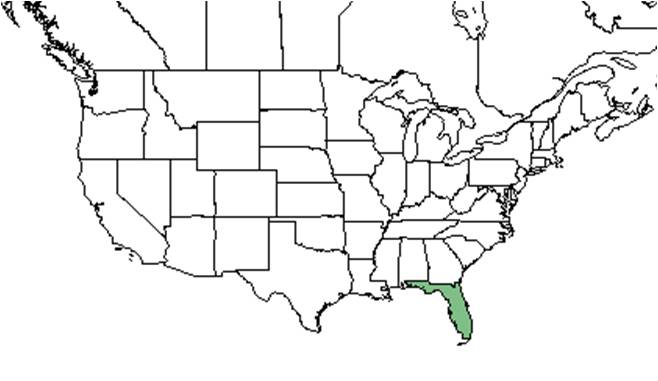Hypericum cumulicola
| Hypericum cumulicola | |
|---|---|
Error creating thumbnail: Unable to save thumbnail to destination
| |
| Scientific classification | |
| Kingdom: | Plantae |
| Division: | Magnoliophyta - Flowering plants |
| Class: | Magnoliopsida - Dicotyledons |
| Order: | Theales |
| Family: | Clusiaceae ⁄ Guttiferae |
| Genus: | Hypericum |
| Species: | H. cumulicola |
| Binomial name | |
| Hypericum cumulicola (Small) P. Adams | |

| |
| Natural range of Hypericum cumulicola from USDA NRCS Plants Database. | |
Common name: Highlands Scrub St. John's-wort
Contents
Taxonomic notes
Description
H. cumulicola is a short live perennial herb whose stems die back in winter to non-flowering basal branches [1]. The leaves are needle like and opposite, entire, simple, and gland-dotted. The seeds are pointed, opening into three curved, beaked segments, surrounded by 5 persistent sepals [2]. The yellow flowers are small, bisexual, and arranged in a cyme. It may contain hypericin, which is common of species in this genus [3]. The leaves and flowers are similar to Hypericum gentianoides, but can be differentiated by having a single, winged-angled main stem and lacking a cluster of basal branches [1].
Distribution
It is a federally endangered species due to habitat loss, fragmentation, and fire suppression[2]. It is endemic to the Lake Wales Ridge, with populations occurring only in Polk and Highland counties. However; within these counties, this species occurs in relatively large populations of hundreds or thousands of individuals [3].
Ecology
Habitat
Hypericum cumulicola can be found in openings of rosemary balds and oak scrubs. Rosemary balds are unique vegetative communities that occur as patches within the more expansive scrub ecosystem found in the Lake Wales Ridge[3]. The fire frequency of rosemary balds range from 10 to 100 years (Johnson 1992, Myers 1990) and extended periods of fire suppression results in a loss of openings preferred by this species[3]. Associated species include Ceratolia, Selaginella, Pinus clausa, Prunus geniculata, Polygonella, and Paronychia pulvinata (FSU Herbarium).
Phenology
Flowers July through November and fruits Septemberthrough November[2](FSU Herbarium). The mature seeds are pointed and opening into three curved, beaked segments, surrounded by five persistent sepals [2]. Fruit set alone is not a reliable measure of reproductive output because fruits can form regardless of the number of seeds they contain, as long as there is at least one viable seed (Trager et al. 2005). The yellow flowers are bisexual, with approximately 27 anthers, and arranged in a cyme[3]. It is a self compatible species but herkogomaous and requires insect visitors for high rates of pollination (Evans et al. 2003).
Seed dispersal
There is no obvious primary dispersal mechanism and seeds are probably dispersed passively by gravity [3].
Seed bank and germination
H. cumulicola is an obligate seeder and forms long lived seed banks (Menges and Kohfeldt 1995; Quintana-Ascencio et al. 1998). Seedling survival and germination are high in recently burned areas, but are low in areas of fire suppression (Quintana-Ascencio & Menges 2000). Stephens and Castro-Morales et al. (2012) found that seed predators (mostly invertebrates) removed more seeds in intact scrubs than in degraded scrubs, because they can use the low shrub cover and associated litter to hide from carnivorous predators. This study also found higher germination rates in bare sand than in litter only or under shrubs.
The biological soil crust in rosemary balds is dominated by algae, cyanobacteria, fungi, and bacteria. Hawkes (2004) found that there was a higher rate of germination in intact soil crusts compared to degraded crusts.
Fire ecology
Fire intervals in rosemary balds range from 10 to 100 years (Johnson 1992; Myers 1990). Fire is important in keeping gaps, that allow H. cumulicola to grow without being impacted from allelopathic chemicals leached from Ceratiola ericoides (Hewitt and Menges 2008). It is an obligate seeder and is sensitive to fire return intervals due to the timing of seedling recruitment, reproductive maturation, and senescence. The density of H. cumulicola was the highest between the third and fourth year after fire and declined the following years (Quintana-Ascencio 2003). The smallest individuals have been observed to have the highest growth rate in recently burned patches. Recruitment decreases in patches more than a decade post-fire (Quintana-Ascencio and Morales-Hernandez 1997).
Pollination
There is limited gene flow among isolated populations due to pollination by specialized bees that move short distances (Menges et al. 2001).
The following Hymenoptera families and species were observed visiting flowers of Hypericum cumulicola at Archbold Biological Station (Deyrup 2015):
Apidae: Bombus impatiens
Halictidae: Augochloropsis sumptuosa, Lasioglossum miniatulus, L. nymphalis
Use by animals
Diseases and parasites
Conservation and Management
Cultivation and restoration
Photo Gallery
References and notes
Deyrup, M.A. and N.D. 2015. Database of observations of Hymenoptera visitations to flowers of plants on Archbold Biological Station, Florida, USA.
Florida State University Robert K. Godfrey Herbarium database. URL: http://herbarium.bio.fsu.edu. Last accessed: October 2015. Collectors: W.P. Adams , Beverly Judd, Walter S. Judd, O. Lakela, James D. Ray Jr., D.B. Ward. States and Counties: Florida: Highlands, Polk. Compiled by Tall Timbers Research Station and Land Conservancy.